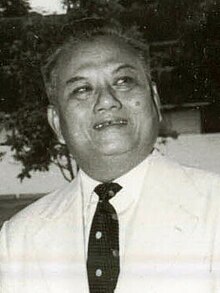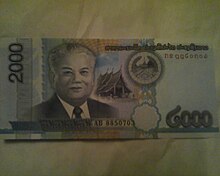Kaysone Phomvihane
Kaysone Phomvihane | |
|---|---|
ໄກສອນ ພົມວິຫານ | |
 Kaysone in 1978 | |
| General Secretary of the Lao People's Revolutionary Party[a] | |
| In office 22 March 1955 – 21 November 1992 | |
| Succeeded by | Khamtai Siphandon |
| 2nd President of Laos | |
| In office 15 August 1991 – 21 November 1992 | |
| Prime Minister | Khamtai Siphandon |
| Preceded by | Phoumi Vongvichit (Acting) |
| Succeeded by | Nouhak Phoumsavanh |
| 11th Prime Minister of Laos | |
| In office 8 December 1975 – 15 August 1991 | |
| President | Souphanouvong Phoumi Vongvichit (Acting) |
| Preceded by | Souvanna Phouma |
| Succeeded by | Khamtai Siphandon |
| Personal details | |
| Born | Nguyễn Cai Song 13 December 1920 Savannakhet, French Indochina |
| Died | 21 November 1992 (aged 71) Vientiane, Laos |
| Political party | Lao People's Revolutionary Party |
| Spouse | Thongvin Phomvihane |
| Children | 4, including Saysomphone, Thongsavanh |
| a. ^ General Secretary of the Central Committee of the Lao People's Party until February 1972; General Secretary of the Central Committee of the Lao People's Revolutionary Party until March 1991; Chairman of the Central Committee of the Lao People's Revolutionary Party since March 1991 | |
Kaysone Phomvihane (Lao: ໄກສອນ ພົມວິຫານ, pronounced [kàj.sɔ̌ːn pʰóm.wī(ʔ).hǎːn];[1] 13 December 1920 – 21 November 1992) was the first leader of the Communist Lao People's Revolutionary Party from 1955 until his death in 1992. After the Communists seized power in the wake of the Laotian Civil War, he was the de facto leader of Laos from 1975 until his death. He served as the first Prime Minister of the Lao People's Democratic Republic from 1975 to 1991 and then as the second President from 1991 to 1992. His theories and policies are officially known as Kaysone Phomvihane Thought.
Biography

Kaysone was born Nguyễn[citation needed] Cai Song[2] (although he also used the name Nguyễn Trí Mưu for a short period in the 1930s) in Na Seng village, Khanthabouli district, French Indochina (now Kaysone Phomvihane District, Savannakhet Province, Laos). His father, Nguyễn Trí Loan, was Vietnamese and his mother, Nang Dok, was Lao. He had two sisters: Nang Souvanthong, living in Thailand, and Nang Kongmany, who lived in the USA.[3]
He attended law school at University of Indochina in Hanoi alongside fellow future revolutionary Nouhak Phoumsavan, but dropped out to fight the French colonialists in Vietnam. Later, he joined the Pathet Lao movement.
He became an active revolutionary while studying in Hanoi during the 1940s, establishing the Lao People's Liberation Army (LPLA) on 20 January 1949 and becoming the Minister of Defense of the Resistance Government (Neo Lao Issara) from 1950. In 1955, he was instrumental in setting up the LPRP at Xam Neua in the north, and subsequently served as the Pathet Lao leader. For several years, he mostly stayed in the background, with Prince Souphanouvong serving as the Pathet Lao's figurehead. In the years which followed, he led communist forces against the Kingdom of Laos and U.S. forces.



Kaysone came out of the shadows in December 1975, shortly after the Pathet Lao took Vientiane, and seized control of the country. At a National Conference of People's Representatives that opened on December 1, Kaysone declared the abolition of the monarchy and the establishment of a republic. The following day, on a motion by presiding officer Kaysone, the National Conference accepted King Sisavang Vatthana's abdication, abolished the monarchy, and proclaimed the Lao People's Democratic Republic. Kaysone nominated Souphanouvong as first president, while he was named prime minister, which he held until becoming president in 1991. Along the way, he married Thongvin Phomvihane.
Under Kaysone's watch, the process of demarcating the border between Laos and Vietnam started in 1977 and finished in 2007. According to Western journalists, the border is "very close" to the 1945 French-made border between Laos and Annam.
According to Vatthana Pholsena, assistant professor of Southeast Asian Studies at the National University of Singapore and author of the book "Post-War Laos", Kaysone was "the top policy maker and a strongman in the LPDR". He created Sekong Province to honour the southern minority for their support in the war effort.
Kaysone died in Vientiane on 21 November 1992. After his death, the government of Laos built a museum in his honor, partially funded by Vietnam.[4]
In 2012, his cremated ashes were transferred from their original resting place to the newly built National Cemetery.[5]
Family
Kaysone had four sons: Saysomphone, Thongsavanh, Sanyahak, and Santiphap, all of whom went on to hold important positions in the LPRP. Saysomphone served as President of the Lao Front for National Construction and currently serves as President of the National Assembly. Thongsavanh is the head of the LPRP External Relations Committee. Sanyahak was elected to the LPRP Central Committee at the 8th LPRP Congress and became a Major General at the age of 40 in 2008. However, he suffered an early death on 19 July 2013 at the age of 45.[6] Santiphap currently serves as Governor of Savannakhet Province.
Foreign honours
 Thailand: Knight of the Order of the Rajamitrabhorn
Thailand: Knight of the Order of the Rajamitrabhorn Cuba: Grand Cross of the Order of José Martí
Cuba: Grand Cross of the Order of José Martí Vietnam: Gold Star Order
Vietnam: Gold Star Order Philippines: Grand Collar of the Order of Sikatuna
Philippines: Grand Collar of the Order of Sikatuna Indonesia: Star of the Republic of Indonesia, 1st Class
Indonesia: Star of the Republic of Indonesia, 1st Class Austria: Grand Star of the Decoration of Honour for Services to the Republic of Austria
Austria: Grand Star of the Decoration of Honour for Services to the Republic of Austria Soviet Union:
Soviet Union:
See also
References
- ^ "English Dictionary - Grammar - Phomvihane". Collins English Dictionary. Archived from the original on 8 December 2023. Retrieved 8 December 2023.
- ^ Asia & Pacific Review. Published by World of Information, 1994, ISBN 0-7494-1069-8, pg 117
- ^ Arthur J. Dommen, The Indochinese Experience of the French and the Americans: Nationalism and Communism in Cambodia, Laos, and Vietnam, Indiana University Press, 2001, ISBN 0-253-33854-9, pg 181
- ^ "Former President Kaysone Phomvihane Memorial Museum". Visiting Arts, Laos Cultural Profile. Archived from the original on December 25, 2007. Retrieved 2007-09-10.
- ^ Tappe, Oliver (6 April 2012). "Revolutionary remains". New Mandala. Retrieved 23 February 2021.
- ^ "Rising Laos political star dies". Bangkok Post. 19 July 2013. Retrieved 28 July 2018.

